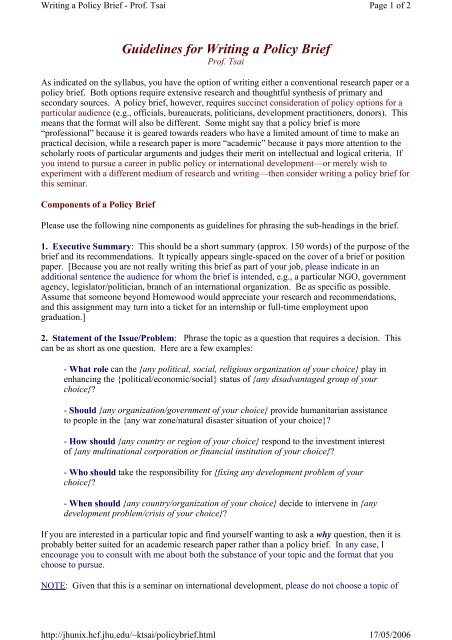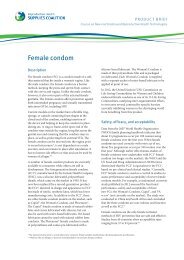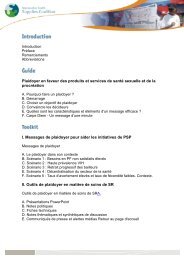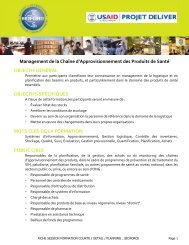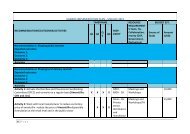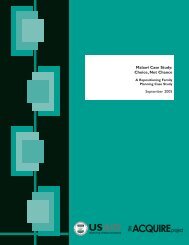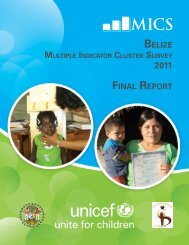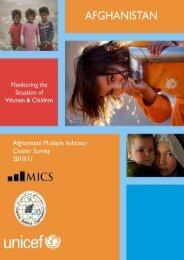Guidelines for Writing a Policy Brief
Guidelines for Writing a Policy Brief
Guidelines for Writing a Policy Brief
- No tags were found...
Create successful ePaper yourself
Turn your PDF publications into a flip-book with our unique Google optimized e-Paper software.
<strong>Writing</strong> a <strong>Policy</strong> <strong>Brief</strong> - Prof. Tsaihttp://jhunix.hcf.jhu.edu/~ktsai/policybrief.htmlPage 1 of 217/05/2006<strong>Guidelines</strong> <strong>for</strong> <strong>Writing</strong> a <strong>Policy</strong> <strong>Brief</strong>Prof. TsaiAs indicated on the syllabus, you have the option of writing either a conventional research paper or apolicy brief. Both options require extensive research and thoughtful synthesis of primary andsecondary sources. A policy brief, however, requires succinct consideration of policy options <strong>for</strong> aparticular audience (e.g., officials, bureaucrats, politicians, development practitioners, donors). Thismeans that the <strong>for</strong>mat will also be different. Some might say that a policy brief is more“professional” because it is geared towards readers who have a limited amount of time to make anpractical decision, while a research paper is more “academic” because it pays more attention to thescholarly roots of particular arguments and judges their merit on intellectual and logical criteria. Ifyou intend to pursue a career in public policy or international development—or merely wish toexperiment with a different medium of research and writing—then consider writing a policy brief <strong>for</strong>this seminar.Components of a <strong>Policy</strong> <strong>Brief</strong>Please use the following nine components as guidelines <strong>for</strong> phrasing the sub-headings in the brief.1. Executive Summary: This should be a short summary (approx. 150 words) of the purpose of thebrief and its recommendations. It typically appears single-spaced on the cover of a brief or positionpaper. [Because you are not really writing this brief as part of your job, please indicate in anadditional sentence the audience <strong>for</strong> whom the brief is intended, e.g., a particular NGO, governmentagency, legislator/politician, branch of an international organization. Be as specific as possible.Assume that someone beyond Homewood would appreciate your research and recommendations,and this assignment may turn into a ticket <strong>for</strong> an internship or full-time employment upongraduation.]2. Statement of the Issue/Problem: Phrase the topic as a question that requires a decision. Thiscan be as short as one question. Here are a few examples:- What role can the {any political, social, religious organization of your choice} play inenhancing the {political/economic/social} status of {any disadvantaged group of yourchoice}?- Should {any organization/government of your choice} provide humanitarian assistanceto people in the {any war zone/natural disaster situation of your choice}?- How should {any country or region of your choice} respond to the investment interestof {any multinational corporation or financial institution of your choice}?- Who should take the responsibility <strong>for</strong> {fixing any development problem of yourchoice}?- When should {any country/organization of your choice} decide to intervene in {anydevelopment problem/crisis of your choice}?If you are interested in a particular topic and find yourself wanting to ask a why question, then it isprobably better suited <strong>for</strong> an academic research paper rather than a policy brief. In any case, Iencourage you to consult with me about both the substance of your topic and the <strong>for</strong>mat that youchoose to pursue.NOTE: Given that this is a seminar on international development, please do not choose a topic of
<strong>Writing</strong> a <strong>Policy</strong> <strong>Brief</strong> - Prof. Tsaihttp://jhunix.hcf.jhu.edu/~ktsai/policybrief.htmlPage 2 of 217/05/2006purely domestic (US) concern. Topics regarding US intervention elsewhere, however, areacceptable.3. Background (of the problem): Include only the essential facts that a decision maker “needs toknow” to understand the context of the problem. Assume that you have been hired to filter throughreams of in<strong>for</strong>mation on behalf of a very busy and sleep-deprived person. Be clear, precise, andsuccinct.4. Statement of your organization’s interests in the issue: This is meant to remind the reader ofwhy the issue matters <strong>for</strong> the country/group/organization that you are advising. If, <strong>for</strong> example, youwere the National Security Advisor <strong>for</strong> the US, then it would be appropriate to review the US’sgeostrategic, economic, or humanitarian interest in the problem at hand.5. Pre-existing Policies: This summarizes what has been done (by others and the entity that yourepresent) about the problem thus far. Depending on your topic, some of the in<strong>for</strong>mation may havealready been presented in #3 (e.g., perhaps the problem itself stems from some other country ororganization’s intervention). The objective of this section is to in<strong>for</strong>m the reader of policy optionsthat have already been pursued, if any. Note that the absence of action may be considered a policydecision.6. <strong>Policy</strong> Options: This section delineates the possible courses of action or inaction that yourorganization may pursue. Please provide the decision maker with at least three potential courses ofaction. Some of them may be wildly unrealistic in your opinion, but please pose them as policyoptions nonetheless. At the same time, it would not be prudent to overwhelm the decision makerwith too many choices. I would cap the menu of options at five choices--just think of how hard it isto choose your courses each semester.7. Advantages and Disadvantages of Each <strong>Policy</strong> Option: Write this section from theperspective of the entity that you represent. For clarity, you may present the pros and cons of theoptions in bullet points or outline <strong>for</strong>mat. This may seem like stacking the deck since some optionsmay have only one advantage and several downsides, but it isn’t always that obvious. For instance,one measly advantage may con<strong>for</strong>m most fully with the interests of the organization summarized in#4. It is up to you to advise the decision maker if it is worth it.8. Your Recommendation: After prioritizing the relative pros and cons of the above options,please recommend one option to your employer. Yes, this may require going out on a limb on anextremely complex issue that challenges your ethical instincts. But if you have agreed to advise aparticular country/organization/person, then you will be asked to make a recommendation on theirbehalf.9. Sources Consulted or Recommended: This is essentially an annotated bibliography in theevent that the decision maker has the interest and time to read up on a specific issue. Please providea one to three sentence description and evaluation of each source listed in this section. Aside fromstandard books and articles, on-line sources and personal interviews may be cited. Please see me ifyou have any questions about the acceptability of your research materials.Back to top of page | Back to first page | Back to 190.363 Course PageLast updated: September 9, 2003


